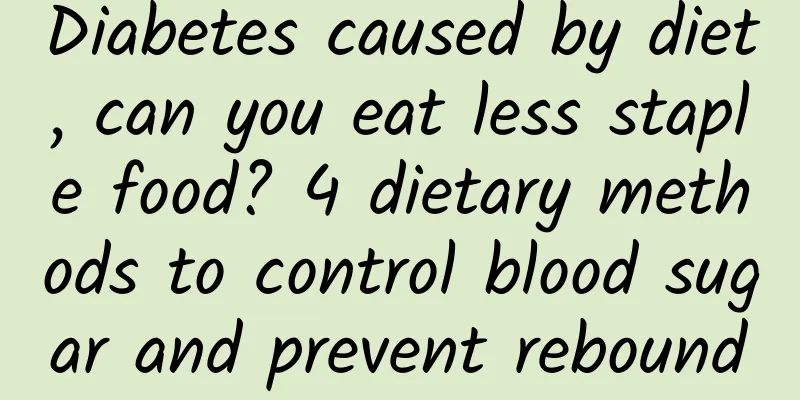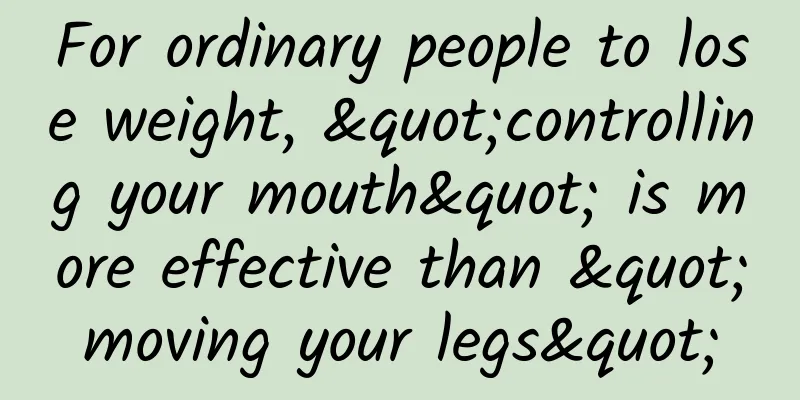Diabetes caused by diet, can you eat less staple food? 4 dietary methods to control blood sugar and prevent rebound

|
Currently, the incidence of diabetes in China is very high. Because diabetes often causes high blood sugar, most people have a misunderstanding that diabetes is caused by eating staple foods. As a result, they begin to reduce their intake of staple foods or simply stop eating staple foods. What consequences will this practice cause? If you don't eat staple food for a long time, your body will not take in enough carbohydrates for a long time, and the function of pancreatic β cells will decline, which will reduce the secretion of insulin, and at the same time, the sensitivity of insulin will also decrease, and the function of glucose degradation will weaken. The undegraded sugar will remain in the blood, which will cause high blood sugar. If this condition continues, even if you resume a normal diet, if the body's insulin secretion cannot meet the requirements, the undegraded glucose will cause blood sugar to rise, and diabetes is likely to occur. This is also a common cause of type 2 diabetes. Eating less staple food makes people hungry easily, so many people eat side dishes to supplement their hunger. Some people like to eat snacks with high fat content such as melon seeds, walnuts, and peanuts; some people eat more vegetables, and the intake of oil and protein in the dishes is very high, which may even exceed the calories of starch in rice and flour, which will also cause excessive calorie intake. These factors may cause metabolic disorders. The carbohydrates contained in cereals are the most basic energy source for the body. According to the "Guidelines for Medical Nutritional Treatment of Diabetes in China (2013)", carbohydrates should account for 45%-60% of the total energy per day. At the same time, the metabolic systems of the human body restrict each other. Eating less staple food will also cause fat metabolism disorders. Fat metabolism disorders are the cause of sugar metabolism disorders and can also induce diabetes. Obesity caused by excessive fat accumulation is also the starting factor of "metabolic syndrome" such as diabetes. Carbohydrates in staple foods have the function of protecting proteins. If you do not eat staple foods, you are prone to malnutrition. Especially for diabetics who do not eat staple foods, they may mobilize the body's fat decomposition to provide energy, leading to the production of ketone bodies, and in severe cases, there is a risk of ketoacidosis. Therefore, for diabetics, not eating staple foods is not only unhelpful in controlling blood sugar, but may also affect the functions of other organs in the body. So how should people with diabetes eat? The first principle of a diabetic diet is to control your diet. Lowering blood sugar actually means eating less or no foods that easily cause blood sugar to rise. For example, foods with added sugar, such as candy, soda, cola, candied fruit, honey, sweetened beverages, and various Chinese and Western desserts should be eaten less; if you are addicted to sweets, it is recommended to use saccharin or aspartame as a sugar substitute for flavoring. In addition, foods with high starch content should also be limited, such as sweet potatoes, potatoes, taro, corn, water chestnuts, as well as sesame cakes, steamed buns, radish cakes, etc.; especially various New Year foods, such as rice dumplings, moon cakes, and rice cakes, which are especially "avoided" by diabetic patients. The secondary principle of diabetic diet is to eat less sweet, salty and oily food. Since obesity is the enemy of diabetes, and the risk of cardiovascular disease in patients with diabetes is higher than that of the general population, it is very important to control the intake of fat. In addition to eating less fried, pan-fried, crispy and high-fat foods such as fatty meat, pig skin, pine nuts, walnuts, peanuts, etc. At the same time, we should limit meat consumption, reduce the intake of animal fat, and use vegetable oil to cook food. In addition, we should also eat less foods with high cholesterol, such as animal offal, egg yolks, seafood, etc. In cooking, we should try to use light and less oil methods, such as stewing, roasting, braising, braising, steaming, boiling, and cold mixing. What should diabetics pay attention to when eating? 1. Timing, quantity and breaking down the whole into parts Regular and quantitative meals refer to regular meals. Normal people are recommended to eat three meals a day, eat regularly, and keep the amount of food they eat at each meal basically stable. The purpose of doing this is to better match the hypoglycemic drugs and avoid the situation of blood sugar levels fluctuating. Breaking the whole into small pieces refers to snacks. When blood sugar is well controlled, we can allow patients to eat fruit to supplement vitamins. However, the way of eating is different from that of normal people. Generally, do not eat immediately after a meal. You can choose to eat fruit 2 hours after a meal. When eating, divide the fruit into small pieces, such as: eat an apple in 2-4 times, instead of eating it all at once. The more times you divide the meal, the less impact it has on blood sugar. 2. Eat dry food instead of liquid food It is recommended that diabetics eat dry food as much as possible, such as steamed bread, rice, and cakes. Do not eat noodle paste, porridge/rice soup, noodle soup, etc. The thinner the food, the longer it takes to cook, the softer and more rotten the food is, which means it is easier to digest, and the faster the blood sugar rises, so no matter what kind of porridge, it is not suitable to eat. 3. Eat hard food, not soft food In the diabetic diet, we recommend "harder" rather than "softer" for the same dry food. The reason is the same as above. 4. Eat green, not red There are too many foods, and many patients are not sure which ones they should eat and which ones they should not eat. Generally, green foods are mostly plants that contain chlorophyll, such as green vegetables. Red foods are relatively high in sugar and should not be eaten. For example, if you eat the same weight of cucumbers and tomatoes, tomatoes can significantly increase blood sugar. Therefore, in the case of uncertainty, "green" foods are generally safer. |
>>: How to eat duck intestines? How to identify duck intestines
Recommend
What causes burning sensation inside the vagina?
Vaginal burning is a very uncomfortable symptom a...
The most obvious symptoms of hypothyroidism in pregnant women
Hypothyroidism is still relatively common among m...
What should I do if the leaves of jasmine are dry and easy to fall off? Why do jasmine leaves fall off when touched?
Jasmine flowers are pure white, fragrant, and hav...
What are the causes of menstrual disorders during adolescence?
Only when a girl has her first menstruation does ...
Pregnant women eating ice cream will affect the fetus
Ice cream is loved by our female friends in daily...
What are the symptoms of adenomyosis?
The cause of adenomyosis is very complicated, and...
Can pregnant women eat cranberries?
Cranberry is a fruit with relatively high nutriti...
How to quickly replenish qi and blood for women
Deficiency of both Qi and blood in women can caus...
Why do I have lower abdominal cramps when my period doesn’t come?
As we all know, women's menstrual cycle is ab...
Acupuncture for infertility
Infertility is a problem that many couples will e...
What to do if you get pregnant one month after uterine curettage
The neighbor's daughter-in-law had to undergo...
Stir-fried dishes suitable for pregnant women are both nutritious and delicious
Due to the influence of hormones in the body, wom...
What are the taboos during pregnancy?
Nowadays, eugenics and good parenting have become...
Can I do color Doppler ultrasound when preparing for pregnancy?
When preparing for pregnancy, female friends will...









